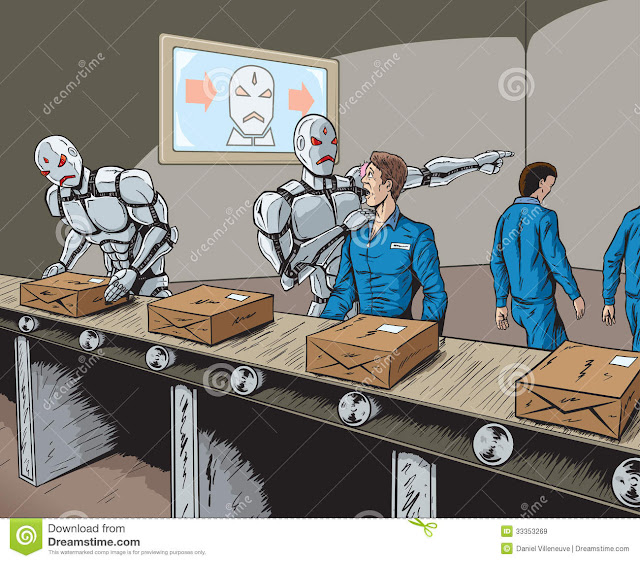Will Automation Eat Up Your Job?
 |
| Automation is here to stay. |
The last five hundred years have been earmarked with significant milestones; progress and developments that have changed the course for mankind. The first industrial revolution, major strides in the field of computing, the mind-boggling evolution of technology, and hundreds (if not thousands) of other innovations and inventions have collectively redefined employment and everything under its umbrella in umpteen ways. The emergence of automation is a causal effect of these advancements and it’s here to stay.
Rarely do life-changing technical innovations receive a warm reception at the beginning. People, especially self-proclaimed pundits, tend to be apprehensive and critical of new tech. Automation is no different—many view it as a double-edged sword that while saving time and increasing efficiency could leave many jobs redundant and millions across the globe jobless. It’s a hot-button issue that has caught the attention of several organizations globally, and millions of dollars are being invested in research to deduce whether automation is a serious concern. A study by McKinsey Global Institute done in 2017 shed light on the need for workers to upskill themselves and change occupational categories to remain relevant. It was also revealed that only 5% of around 830 occupations analyzed could be completely automated. At the same time, another finding pointed out that nearly every kind of job had the scope for incorporating automation in some manner. However, not all studies heap praises on this burgeoning domain. Oxford Economics released a report titled ‘How Robots Change the World’ in June 2019, and the results at first glance look alarming: 20 million manufacturing jobs are estimated to be lost to robots by 2030, an industrial robot displaces an average of 1.3 workers in its first year of deployment, and 1.7 million jobs have ceased to exist since 2000 due to the arrival of automation tools and robots. While there’s no denying the numbers, the stats alone shouldn’t be the edifice for any kind of pessimistic conclusion. A Gartner press report of December 2017 mentioned that artificial intelligence, a component essential to automated tech stack, would create 2.3 million jobs in 2020 while eliminating 1.8 million. It’s clear that reports, editorials, opinions, etc. are not painting a clear picture about the impact of automation on jobs; they are being snatched away but in parallel to new occupations being created (albeit ones that are not menial).
The world is all about computers today and digitization is the norm. More than thirty computer software and information organizations rank on the Fortune 500 list. If one skims through this highly revered list, he or she will find technology on par with petroleum, energy, chemicals, automobiles, retail, industrials, and transportation—industries and verticals that precede information technology by several decades. And it’s the domain that shall spearhead every major advancement our civilization will see through in the coming years. So studying the impact of automation in the IT industry is imperative. Robotic Process Automation, abbreviated as RPA, is business process automation technology that uses software robots to mimic human actions. This could be as simple as performing data processing in SAP, Excel, a database, etc., or as complex as the end-to-end invoice processing done by a company’s finance department. Leading RPA vendors such as UiPath, Automation Anywhere, and BluePrism—whose tools are used to build software robots—have a plethora of success stories to share. Companies saving thousands of dollars yearly in full-time employee (FTE) savings, efficiency in process execution, and identification of use cases previously thought of requiring manual intervention (a human operator behind the controls) are just some of the benefits that have been realized lately with the emergence of RPA. A report by Protiviti highlights the numerous advantages Robotic Automation brings to the table. And all of these justify why it makes sense to let go off your employees and use a software robot in their place. Robots taking away jobs in the IT sector is evident. Forrester attests to this claim in its automation-related predictions for 2020. But these predictions have something to say about the opposite end of the spectrum as well. While robots shall constitute a greater proportion of organizations’ workforce, new career opportunities will spring up wherever the human touch/element is required. Your robot may be capable of crunching hours and hours of data processing, but in no way (at least till the time humanoids replace homo sapiens) can it negotiate client deals and close off sales-related assignments. These tasks require socializing, pursuance, and emotional manipulation at times.
An article by the MIT Sloan Management Review briefly sums up the ‘automation anxiety’ debate. The first industrial revolution resulted in professions, as old as 1000 years, going extinct with the modernization of factories. While people lost jobs in the process, new types of jobs came into existence. The same is the case with automation and the elimination of unspecialized jobs. The professions lying at the lower rung of the ladder in terms of skills required and redundancy will be shown the door. But at the cost of this cleansing, new vacancies to deal with sophisticated and complex technology shall arise. Soft skills would be valued more than ever.
At the end of the day, new technologies are nothing but a funnel as they block out impediments and filter the fine granular material. The same is the case with automation; it’s going to remove occupations that have reached their shelf-life to pave the way for advanced and efficient replacements.


Comments
Automation Anywhere Training in Chennai
Automation courses in Chennai
Automation Anywhere online Training
Openspan Online Training
Openstack Online Training